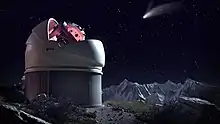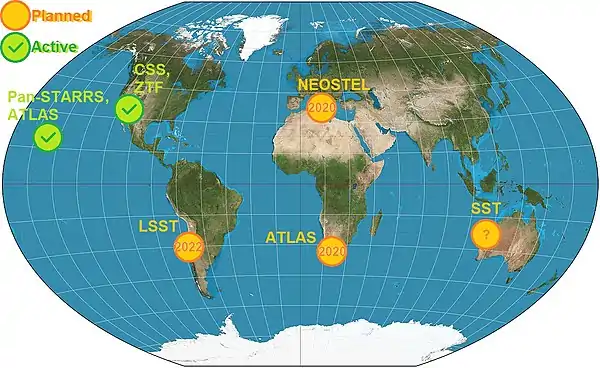NEOSTEL
The Near Earth Object Survey TELescope (NEOSTEL - also known as "Flyeye") is an astronomical survey and early-warning system for detecting near-Earth objects sized 40 metres (130 feet) and above a few weeks before they impact Earth.[1][2][3]
 Artist's impression of the completed NEOSTEL "flyeye" telescope | |
| Alternative names | Flyeye |
|---|---|
| Survey type | astronomical survey |
| Target | Asteroid impact prediction |
| Observatory code | TBD |
NEOSTEL is a project founded by the European Space Agency (ESA), starting with an initial prototype currently under construction at OHB in Milan, Italy. The telescope is of a new "fly-eye" design inspired by the wide field of vision from a fly's eye. The design combines a single objective reflector with multiple sets of optics and CCDs, giving a very wide field of view (around 45 deg2, or 220 times the area of the full moon). When complete it will have one of the widest fields of view of any telescope and be able to survey the majority of the visible sky in a single night. If the initial prototype is successful, three more telescopes are planned, in complementary positions around the globe close to the equator.[1][2][4][5]
In terms of light gathering power, the size of the primary mirror is not directly comparable to more conventional telescopes because of the novel design, but is equivalent to a conventional 1-metre telescope and should have a limiting magnitude of around 21.[1][2][6]
The project is part of the NEO Segment of ESA's Space Situational Awareness Programme.[7] The telescope itself should be complete by end of 2019, and installation on Mount Mufara, Sicily should be complete in 2020, having been agreed with the Italian Space Agency in October 2018.[2][3][8] Development of the telescope was reported as on track in Feb 2019.[9]
Optics
The fly eye aspect of the telescope refers to the use of compound optics, as opposed to the single set of optics used in a conventional telescope. Classically, telescopes were designed around a single human observer looking through an eye piece. Astrographs were developed in the 19th century where a photographic plate, or later a CCD, records the image, which a human observer can then view. With the human eye no longer directly observing the image there is no longer a restriction on a single viewing point, and asteroid detection software has become fully automated, so a human observer need not view the majority of images at all.
Light enters the NEOSTEL telescope through the aperture and is reflected off the primary mirror onto a beam splitter, which is a hexadecagonal pyramid in shape. The split beam then passes into 16 separate aspheric lenses and on to 16 corresponding CCD image sensors.[10] NEOSTEL uses the 16 CCD cameras to view 45 square degrees of light entering the telescope aperture. The resolution is 1.5 arc seconds per pixel across the whole field of view.[5][10]
See also
References
- Flyeye: the bug-eyed telescope monitoring our skies [ESA Web TV] on YouTube
- "Flyeye Telescope". ESA. European Space Agency. Retrieved 10 December 2018.
- Hugo, Kristin (13 June 2018). "EUROPEAN SPACE AGENCY'S 'FLYEYE' TELESCOPE COULD SPOT ASTEROIDS BEFORE THEY DESTROY LIFE ON EARTH". Newsweek Tech & Science. Newsweek. Retrieved 10 December 2018.
- Cibin, L; Chiarini, M; Bernardi, F; Ragazzoni, R; Salinari, P (2016). "NEOSTEL: the telescope detail design program for the ESA optical ground network dedicated to NEO discovery and tracking". Memorie della Societa Astronomica Italiana. 87: 197. Bibcode:2016MmSAI..87..197C.
- "Optical and testing elements for the NEOSTEL telescope" (PDF). TOPTEC Research Centre for Special Optics and Optoelectronic Systems. Institute of Plasma Physics of the Czech Academy of Sciences. Retrieved 11 December 2018.
- "ESA's bug-eyed telescope to spot risky asteroids". ESA Space Situational Awareness. European Space Agency. Retrieved 10 December 2018.
- "Near-Earth objects - NEO Segment". European Space Agency. ESA Space Situational Awareness. Retrieved 10 December 2018.
- "One step closer to the Flyeye network". ESA. European Space Agency. Retrieved 10 December 2018.
- Cibin, L; Chiarini, Marco; Gregori, P; Bernadi, F. "The Fly-Eye Telescope, Development and First Factory Tests Results". Research Gate. 1st NEO and Debris Detection Conference. Retrieved 10 May 2019.
- Baker, A. "Flyeye Observatory". ESA. European Space Agency. Retrieved 11 December 2018.
